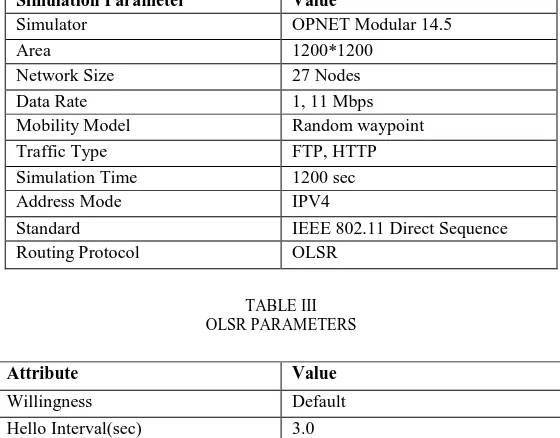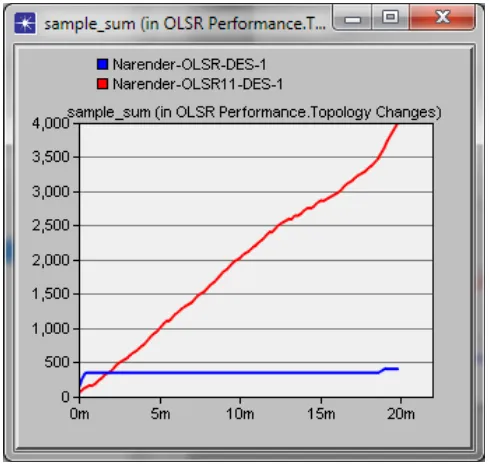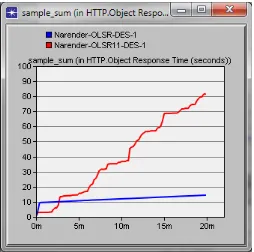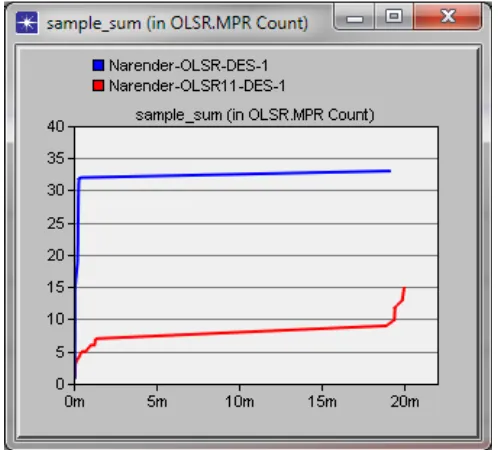© 2015, IJCSMC All Rights Reserved 26 Available Online atwww.ijcsmc.com
International Journal of Computer Science and Mobile Computing
A Monthly Journal of Computer Science and Information Technology
ISSN 2320–088X
IJCSMC, Vol. 4, Issue. 1, January 2015, pg.26 – 35
RESEARCH ARTICLE
Direct Sequence Based Performance Evaluation
of OLSR for 1 Mbps and 11 Mbps Using OPNET
Narender
1, Ravi Antil
2, Jonish
3¹M-Tech Department of ECE, MSIT, Sonepat, Haryana, India ²Assistant Professor, Department of ECE, MSIT, Sonepat, Haryana, India
³Department of CSE, Sonepat, Haryana, India
1
narenn005@gmail.com; 2 antilravi6519@gmail.com; 3 sbit.cse08420@gmail.com
Abstract— In this paper analysis and performance of OLSR is done for 1 and 11 mbps data rate. We used OPNET Simulation tool we created a network containing 27 mobile nodes with data rate 1 Mbps and 11 Mbps with transmission power 0.005 watts and buffer size 256000 bits each node moves randomly in the network and simulation time was 2000 sec. OLSR routing protocol is compared in terms of OLSR Performance Topology changes, FTP Download Response Time(sec), HTTP Object Response Time (sec), WLAN Retransmission Attempts (packets) and OLSR MPR count . According to the resulted performance OLSR performed better in 11 Mbps then 1 Mbps. The simulation result of the research has practical reference value for further study.
Keywords— OLSR, MANET, QOS, OPNET
I. INTRODUCTION
The Optimized Link State Routing Protocol (OLSR) is developed for mobile ad hoc networks (MANET’s). It operates as a table driven, proactive protocol, i.e., exchanges topology information with other nodes of the network regularly. Each node selects a set of its neighbor nodes as "multipoint relays" (MPR). In OLSR, only nodes, selected as such MPR’s, are responsible for forwarding control traffic, intended for diffusion into the entire network. MPRs provide an efficient mechanism for flooding control traffic by reducing the number of transmissions required.
© 2015, IJCSMC All Rights Reserved 27
Routing protocol is the major issue in data communication’s performance of MANET. Hence, routing protocol required is to be effective and accurate so as to handle mobility of nodes and to give best utilization to technology. Routing protocol is a standard that determines how nodes find the way to forward packets between devices in the network. In this paper performance of OLSR protocol is evaluated by using FTP and HTTP application type of IEEE 802.11a/b/g WLAN Standard. [2]
TABLE I
IEEE 802.11 CLASSIFICATIONS
Standard IEEE 802.11a IEEE 802.11b IEEE802.11g
Release Sept 1999 Sept 1999 Jun 2003
Bandwidth(MHz) 20 20 20
Frequency(GHz) 0.5 2.4 2.4
Data Rate(Mbit/s) 6,9,12,18,24,36,48,54 5.5,11 6,9,12,18,24,36,48,54
Modulation OFDM DSSS OFDM,DSSS
II. RELATED WORK
Jonish [1] analyzed the performance of OLSR and TORA routing protocols using OPNET Simulation tool he created a network containing 50 mobile nodes with data rate 1 Mbps and 2 Mbps with transmission power 0.005 watts and buffer size 256000 bits each node moves randomly in the network and simulation time was 1500 sec. TORA and OLSR routing protocols were compared in terms of Traffic Received, Traffic Sent, Network Load, Retransmission Attempts and Throughput. According to the resulted performance OLSR performed better then TORA in both 1 Mbps and 2 Mbps
Anjali [2] analyzed the performance of AODV, OLSR and GRP routing protocols is evaluated for FTP based application traffic on IEEE 802.11 WLAN Standard and 48 Mbps data rate. The network performance is evaluated by using OPNET simulator based on various quantitative metrics- Network Load, Throughput, Retransmission Attempts and Media Access Delay by varying physical characteristics and number of nodes. A comparative performance analysis of these protocols have been carried out in this paper and in the last conclusion will be presented which demonstrate that performance of routing protocols differs by varying the network and selection of accurate routing protocol according to the network ultimately influences the efficiency of the network in a magnificent way.
Ravinder Ahuja [4] evaluated performance of three types of routing protocols (AODV, OLSR and ZRP) based on random waypoint mobility model. In this paper they analyze and compare the performance of protocols using Qualnet 4.5 from scalable network .These routing protocols were compared in terms of Packet delivery ratio, Average end-to end delay and Throughput when subjected to change in no. of nodes and pause time. Simulation results show that Reactive protocols better in terms of packet delivery ratio and throughput
© 2015, IJCSMC All Rights Reserved 28
III. MANET ROUTING PROTOCOLS
With recent performance advancements in computer and wireless communications technologies, advanced mobile wireless computing is expected to see increasingly widespread use and application, much of which will involve the use of the Internet Protocol (IP) suite. The vision of mobile ad hoc networking is to support robust and efficient operation in mobile wireless networks by incorporating routing functionality into mobile nodes. Such networks are envisioned to have dynamic, sometimes rapidly-changing, random, multi-hop topologies which are likely composed of relatively bandwidth-constrained wireless links.
A number of routing protocols are created to be implemented on MANET categorized in three different types according to the functionality
A. Proactive Protocols
In networks utilizing a proactive routing protocol, every node maintains one or more tables representing the entire topology of the network. These tables are updated regularly in order to maintain a up-to-date routing information from each node to every other node. To maintain the up-to-date routing information, topology information needs to be exchanged between the nodes on a regular basis, leading to relatively high overhead on the network. One the other hand, routes will always be available on request. Many proactive protocols stem from conventional link state routing, including the Optimized Link State Routing protocol (OLSR).
1) OLSR
OLSR is a proactive routing protocol for mobile ad-hoc networks (MANETs). [1][2] It is well suited to large and dense mobile networks, as the optimization achieved using the MPRs works well. The larger and more dense a network, the more optimization can be achieved as compared to the classic link state algorithm. OLSR uses hop-by-hop routing, i.e., each node uses its local information to route packets. OLSR is well suited for networks, where the traffic is random and sporadic between a larger set of nodes rather than being almost exclusively between a small specific set of nodes. As a proactive protocol, OLSR is also suitable for scenarios where the communicating pairs change over time: no additional control traffic is generated in this situation since routes are maintained for all known destinations at all times. [6][7]
B. Reactive Protocols
Reactive routing protocols do not make the nodes initiate a route discovery process until a route to a destination is required. This leads to higher latency but lower overhead. Reactive Protocols are bandwidth efficient. Route is determined when a path is required by a node to forward packets. Therefore, overhead routing is decreased because search for the route is not required on which packet is not sent.
C. Hybrid Protocols
© 2015, IJCSMC All Rights Reserved 29
IV. SIMULATION SETUP
This research used software known as OPNET Modeler, Which is a tool provided by the OPNET Technologies in order to undertake the experimental evaluation; the version named OPNET Modeler 14.5 has been adopted for study [8].
OPNET is one of the most extensively used commercial simulators based on Microsoft Windows platform, which incorporates most of the MANET routing parameters compared to other commercial simulators. It simulates the network graphically and gives the graphical structure of actual networks and network components.
TABLE II
SIMULATION PARAMETERS
Simulation Parameter Value
Simulator OPNET Modular 14.5
Area 1200*1200
Network Size 27 Nodes
Data Rate 1, 11 Mbps
Mobility Model Random waypoint
Traffic Type FTP, HTTP
Simulation Time 1200 sec
Address Mode IPV4
Standard IEEE 802.11 Direct Sequence
Routing Protocol OLSR
TABLE III OLSR PARAMETERS
Attribute Value
Willingness Default
Hello Interval(sec) 3.0
TC Interval(sec) 7.0
Neighbor Hold Time(Sec) 8.0 Topology Hold Time(Sec) 20.0
Duplicate Message Hold Time(Sec) 40.0
Addressing Mode IPV4
TABLE IV
WIRELESS LAN PARAMETERS
Attribute Value
Physical Characteristics Direct Sequence
Data Rate 1,11 Mbps
Short Retry Limit 7
Long Retry Limit 4
Max Receive Lifetime (sec) 0.5
Buffer Size(bits) 256000
© 2015, IJCSMC All Rights Reserved 30
Fig. 1 shows the simulation environment of scenario containing 27 WLAN mobile nodes, one fixed WLAN Server, Application definition, Profile definition and Mobility config. We configure the nodes in the scenario to work with 1 Mbps and 11 Mbps data rate.
Fig. 1 Network Model for 27 Nodes scenario
V. PERFORMANCE METRICS
A. OLSR Performance Topology changes
This is how we can check the OLSR Performance over the Topology changes which are to be done during the simulation time.
B. FTP Download Response Time(sec)
Time elapsed between sending a request and receiving the response packet. Measured from the time a client application sends a request to the server to the time it receives a response packet. Every response packet sent from a server to an FTP application is included in this statistic.
C. HTTP Object Response Time (sec)
© 2015, IJCSMC All Rights Reserved 31
D. WLAN Retransmission Attempts (packets)
It is the total number of retransmission attempts by all WLAN MACs in the network until either packet is successfully transmitted or it is discarded as a result of reaching short or long retry limit.
E. OLSR MPR count
The OLSR protocol uses Greedy method for the purpose of Multipoint Relay (MPR) selection or count.
VI. SIMULATION RESULTS AND ANALYSIS
Figure (2 - 6) below shows OLSR Performance Topology changes, FTP Download Response Time(sec), HTTP Object Response Time (sec), WLAN Retransmission Attempts (packets) and OLSR MPR count in 27 mobile nodes scenario for IEEE 802.11 standard at 1 Mbps and 11 MBPS data rate with OLSR. The color scheme is showing the protocols behavior in different graphs which gives the average values. From these average values we will conclude the behavior of all these routing protocols.
A. OLSR Performance Topology changes
Fig. 2 Sample Sum for OLSR Performance Topology changes in 1 and 11 Mbps
© 2015, IJCSMC All Rights Reserved 32
B. FTP Download Response Time(sec)
Fig. 3 Sample Sum for FTP Download Response Time(sec) for OLSR in 1 and 11 Mbps
According to simulation, as we can see in Fig. 3, FTP Download Response time in OLSR 11Mbps is higher than in 1 Mbps.
C. HTTP Object Response Time (sec)
Fig. 4 Sample Sum for HTTP Object Response Time (sec) for OLSR in 1 and 11 Mbps
© 2015, IJCSMC All Rights Reserved 33
D. WLAN Retransmission Attempts (packets)
Fig. 5 Sample Sum for Wireless LAN Retransmission Attempts in packets for OLSR in 1 and 11 Mbps
According to simulation, as we can see in Fig. 5, Wireless LAN Retransmission Attempts in OLSR for 11 Mbps is higher than OLSR 1 Mbps.
E. OLSR MPR count
Fig. 6 Sample Sum for OLSR MPR count in 1 and 11 Mbps
© 2015, IJCSMC All Rights Reserved 34
VII. CONCLUSION
In this paper performance of OLSR is evaluated for metrics like OLSR Performance Topology changes, FTP Download Response Time (sec), HTTP Object Response Time (sec), WLAN Retransmission Attempts (packets) and OLSR MPR count by using 27 nodes scenario with IEEE 802.11 Direct Sequence WLAN Standard in 1 Mbps and 11 Mbps. From the above discussion we find out that OLSR performs better in terms of OLSR Performance Topology changes, WLAN Retransmission Attempts (packets) and OLSR MPR count for 11 Mbps then 1 Mbps. OLSR performs better in terms of FTP Download Response Time (sec), HTTP Object Response Time (sec) for 1 Mbps then 11 Mbps.
TABLE 5 RESULTING VALUES
S. NO.
PERFORMANCE METRICS OLSR (1 Mbps)
OLSR (11 Mbps)
1 TOPOLOGY CHANGES LESS MORE
2 DOWNLOAD RESPONSE TIME LESS MORE
3 OBJECT RESPONSE TIME LESS MORE
4 RETRANSMISSION ATTEMPTS LESS MORE
5 MPRCOUNT MORE LESS
REFERENCES
[1] Jonish1, Kapil Chawla2 Frequency Hopping Based Performance Evaluation of TORA and OLSR
Routing Protocols Using OPNET IJCSMC, Vol. 3, Issue. 11, November 2014, pg.514 – 522
[2] Anjali, Maninder Singh, “Performance Analysis of Proactive, Reactive and Hybrid MANET Routing Protocols on IEEE 802.11 Standard”, International Journal of Computer Applications,pp.1-8,Volume 54-No.12,September 2012.
[3] Anjali, Maninder Singh, “Simulation and Performance Analysis of AODV,OLSR,GRP Routing Protocol by considering IEEE 802.11Standard”,IJARCSSE,Volume2 ,issue 6, pp-171-178,June 2012.
[4] Ravinder Ahuja, “Simulation based Performance Evaluation and Comparison of Reactive, Proactive and Hybrid Routing Protocols based on Random Waypoint Mobility Model”, International Journal of Computer Applications, Vol. 7, No.11, pp. 20-24, Oct. 2010.
© 2015, IJCSMC All Rights Reserved 35
[6] Guo, Z, and Malakooti, S (2010) “Multi-objective OLSR for proactive routing in MANET with delay, energy, and link lifetime predictions” Applied Mathematical Modelling (Elsevier), vol. 35 (6),pp. 1413–1426.
[7] Guo, L, and Peng, Y. (2010) “Performance evaluation for on-demand routing protocol based on OPNET modules in wireless mesh network” Computer and Electrical Engineering (Elsevier), vol. 37(2011), pp. 106-114.
[8] T.H. Clausen, ”The optimized link state routing protocol evaluating through experiments and simulation” mind pass centre for distributed system, Aalborg university ,Denmark.
[9] Kuldeep Vats, “Simulation and performance analysis of OLSR routing protocol using OPNET” IJARCSSE ,Vol. 2, Issue 2, Feb. 2012 .





